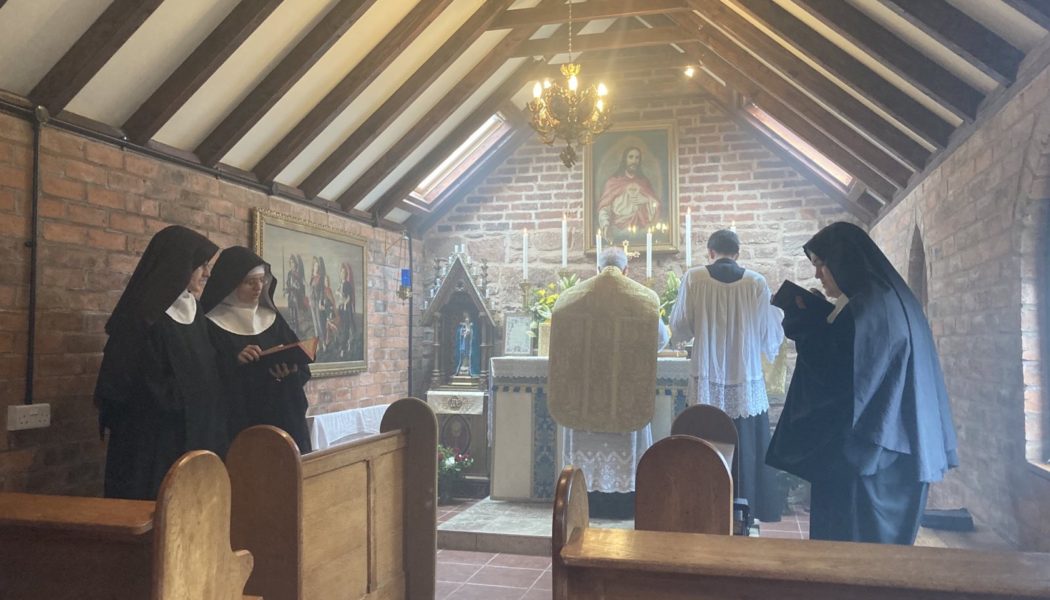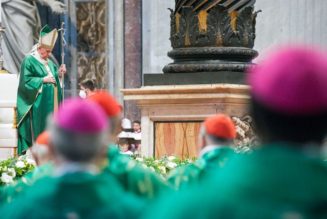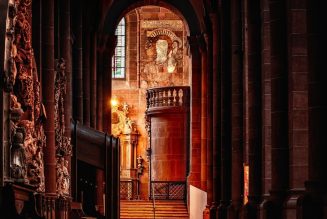The Benedictines of Mary, Queen of Apostles — founded by Sister Wilhelmina Lancaster, whose body was discovered last year to be remarkably well-preserved — shared some exciting news in their spring 2024 newsletter: Not only is this burgeoning religious order, with its motherhouse in Gower, Missouri, putting the finishing touches on its Ava, Missouri, monastery and preparing to move into a recently vacated Poor Clare monastery in Evansville, Indiana, but a combination of necessity and Providence has allowed the sisters to expand beyond the United States to England.
Immigration difficulties have exiled some of the order’s sisters who come from countries outside the U.S.; and, in response, Archbishop Bernard Longley of the Archdiocese of Birmingham, England, has welcomed the order into the archdiocese.
The order’s future home in Staffordshire, England, is St. Mary’s Abbey at Colwich, a monastery rich in history. “Colwich Abbey was founded by Saint Thomas More’s great-great-granddaughter, with nuns once exiled from England during the Elizabethan persecution, and exiled back there during the French Revolution,” Mother Abbess Cecilia Snell wrote in the order’s recent newsletter. She hopes it will be “a place of expansion, especially for future foreign vocations to our community.”


In a recent email interview with the Register, Mother Cecilia shared that the order’s expansion to Colwich Abbey would allow the history of Benedictine tradition in this space to continue:
“The abbey was renowned for adoration of the Blessed Sacrament and its illustrious foundress. Most significantly of all, it is part of the Benedictine refoundations in England. During the persecutions of Henry VIII and Elizabeth I, religious took refuge on the continent of Europe and then headed back to England as soon as they were able. In the case of Colwich, the nuns went back during the French Revolution, as it was no longer safe to remain in France.”
The connection to St. Thomas More, whose feast the Church celebrates on June 22, is another aspect of this unexpected expansion that excites the sisters. Mother Cecilia shared that the saint holds a special place in the order’s heart:
“St. Thomas More has always been very much beloved of our community, and we think of him not just as the patron of lawyers, but as a saint of joy and grace under fire, grace that holds up under the challenges of an age.”
She added, “We consider him a great light for the Church in our day. Thomas More lived in a time when there was much capitulation around him, even in the hierarchy, but he was found a faithful son of the Church. He is also an outstanding example of a married saint, who died as a witness to the sacredness and indissolubility of the traditional marriage bond. More showed himself faithful to his own married vocation in life, and gave courageous testimony in death, refusing to compromise on Christ’s teaching on marriage, even before an earthly king.”
Another light for the sisters is, of course, Sister Wilhelmina. In the midst of the order’s flourishing, she is ever-present. “I am quite sure Sister Wilhelmina would be most delighted to learn of our expansion. She had a great devotion to the martyrs, and especially to the English Martyrs such as Saints Edmund Campion, John Fisher, Thomas More and Margaret Clitherow,” Mother Cecilia said. Interestingly, part of Sister Wilhelmina’s lineage stems from England: “Her roots trace back to the Royal House of Lancaster, which produced Henry V and other famous monarchs.”
Sister Wilhelmina would likely have also been heartened to see a revived desire for monastic life, as evidenced by the daily vocation inquiries the order receives. Of this desire to discern with the order, Mother Cecilia pointed to the unique way of life monasticism calls a person to live.
“I believe there is a thirst for monastic life, because it seems to stand in stark contrast to the world as we know it, a world that is becoming increasingly self-centered,” she said. “Monastic life fosters instead a very God-centered way of life: God-conscious instead of self-conscious, realizing that the world actually revolves around God and not us! In this perennial cycle is found a source of stability that the world cannot offer, one that helps us understand who we truly are, raising us to the dignity of brides of Christ, an ambition we could not undertake except by His calling and His grace.”

This year, Mother Cecilia says, the order will grow to more than 70 sisters, making the need for space beyond the motherhouse in Gower and the daughterhouse at Ava necessary.

Another connection between England and the order is the fact that England has traditionally held the title of “Our Lady’s Dowry,” because, as one Register article explained, “England was ‘set aside’ as a gift for Our Lady,” and Marian devotion is part of the country’s heritage. Under the title of Mary, Queen of Apostles, Sister Wilhelmina’s sisters now have the opportunity to contribute to a reflourishing of Marian devotion in England.
During this time of transition, the sisters ask readers to pray for them in the midst of the unknowns that come with growth, that their trust in the Lord’s providence be deepened. “As it is God’s work, we trust that He will see it through,” Mother Cecilia said. “We only ask that everyone pray that we remain very faithful: very faithful to the vocation to which he has called us.”


As they revive the historic religious spaces in both Staffordshire and Evansville, the Benedictines of Mary, Queen of Apostles attribute another facet of their growth to the witness of their foundress.
“Sister Wilhelmina has really been a tremendous blessing to us in so many ways, but mostly hidden ways. It has been a source of exposure, and more women have heard about us, but I would say that more than hearing about us, Sister Wilhelmina has been the impetus to seek out religious life seriously,” Mother Cecilia said. “They see in the way of life that she founded a sure guide to sanctity through the sign of her own sanctity. It is rather nice to have transitioned from being known as ‘the singing nuns’ to ‘Sister Wilhelmina’s nuns.’ That seems much more appropriate, as Sister Wilhelmina has always been an inspiration, especially for those who knew her.”








